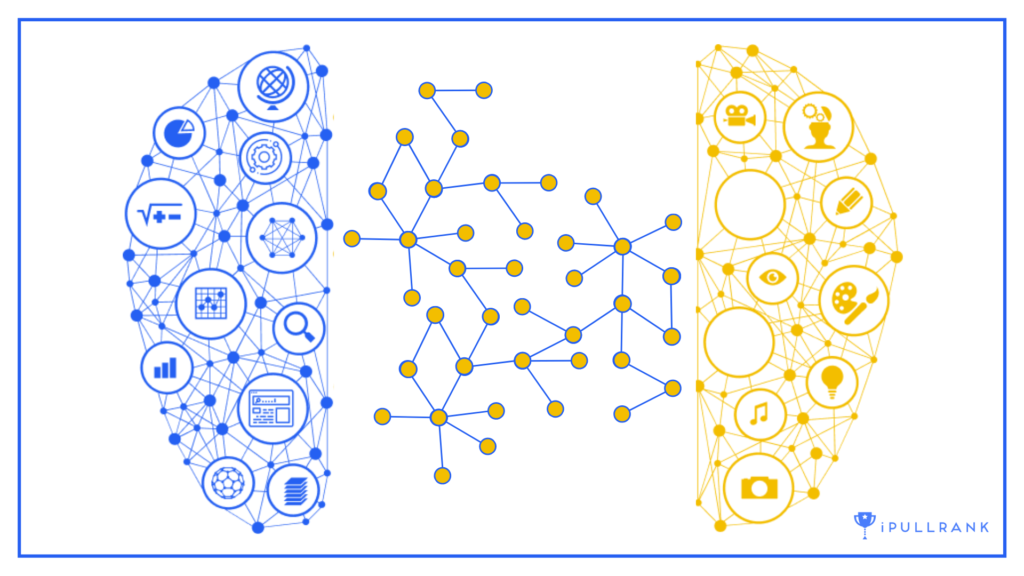Does your agency understand you?
Your content strategy should be focused on one thing — using your content to achieve your organization’s goals and objectives. That’s immediately obvious to most people, but it’s also the place where most agencies stumble.
They ignore the details.
These details identify the things that matter most to your company. If you want your content strategy to produce meaningful results (i.e., drive revenue), your agency needs to be clear on these details. If you’re part of an enterprise building a large content team and you’re looking for meaningful results, iPullRank’s approach to content strategy is your best option.
We’re about to show you why.
The best agencies have a deep understanding of your business
What’s the very first thing they should do?
Your agency should get to know you via client intake questionnaires and kick-off calls; your agency should spend a significant amount of time (upfront) getting to know your team and your organization.
This means they’ll take the time to:
- Assess your team’s skill, experience, and comfort level with content and search. This task isn’t as simple as it sounds — a project manager or point-of-contact may be inexperienced but responsible for working with engineering teams that are moderately skilled at technical search.
- Discuss roles, boundaries, and the expected level of involvement. If you’re a media publisher like The Wall Street Journal, you’re probably fine on the content production front, but you may need help with future-proofing your content strategy. If you’re a large ecommerce provider, you may need comprehensive A-to-Z content strategy and production. Your agency should be able to meet you where you are.
- Outline and discuss your goals, objectives, KPIs, and success metrics. This includes obvious goals like increased visibility in search, boosting conversions, and driving revenue; it also includes murky goals like budget justification or making sure your department isn’t on the chopping block if management needs to restructure.
- Assess your understanding of your audience. How well do you know your audience/customers? What sort of insights do you have on your customer’s desires, expectations, and goals? What do both groups want from you? Do you understand the behavioral drivers of each group?
- Complete the requisite audits: These can be simple or complex —who’s using what in the organization; is everyone using the same CMS? Are different departments or teams responsible for portions of the site? What sort of content production capabilities do you have now?
- Understand the components that matter most to you as a client. These motivations vary from person to person; your agency will probably need to manage these for various roles — decision-makers, project managers, technical leads, and marketers. You’ll need an agency that knows how to harmonize these and handle any unexpected conflict with these details.
This seems common, doesn’t it?
Many agencies do this; the degree of research and preparation separates great agencies from the average. iPullRank’s approach content strategy is research-heavy and data-driven, so we’re forced to dive deep with these upfront issues. The more we understand your business, the better your performance will be.
What makes iPullRank’s approach to content strategy superior?
Our strategy is superior because it’s oriented around the right philosophy. Alexandra Pielusko, Director of Content Strategy, at iPullRank explains.
“The philosophy for our approach to content strategy at iPullRank is, everything has to be backed by a ‘What’ and the ‘Why.’ We’re extremely interested in creating things that are going to be pleasing to the eye. Things that we think will resonate or might be cool ideas, but those cool ideas are only as cool as they are if everybody else sees them and shares them and if they generate traction in the search universe, right?”
The “What” is straightforward, right? It’s tied directly to the goals of your organization. Your “What” tells you what to do.
- Increasing visibility and traffic
- Expanding rankings
- Boosting conversions, driving revenue
- Improving customer engagement (e.g., bounce rates, time-on-site, consumption, etc.)
- Building the kind of topical authority Google craves
- Justifying/increasing your budget
Your “What” is synonymous with your objectives; it provides you with the intel your team needs to move forward. “Why” is synonymous with goals; if it’s done well, it clarifies your “What,” and it gives your team a cause to rally behind (i.e., overtake competitors in search).
- Why do we want more visibility and traffic? To expand our digital footprint
- Why do we want rankings? To dominate the search results for conversion and branded keywords
- Why do we want to build topical authority? So our credibility and reputation will improve
- Why do we want to improve customer engagement? So we can build strong customer relationships
- Why are we trying to justify and increase our budget? So we can beat the low earnings forecasts set for us
See what I mean?
This is why our philosophy is so important. If we’re clear on the “What” and “Why” of your campaign, it’s easier to create a successful content strategy (and content). One that’s backed by the micro, meso, and macro-level “Whats” and “Whys.”
This philosophy is how we generate long-term SEO wins using your existing content.
So why is this important?
Let’s look at the data; research from Seismic shows that:
- 46 percent of enterprise marketers have a documented content strategy
- 49 percent of enterprises used content to generate revenue successfully in the last 12 months however,
- 83 percent focused on early-stage, top-of-funnel (ToFu) content
- 50 percent of the content produced in the previous 12 months was ToFu content
Okay.
About half of enterprise marketers are focused on content strategy; how’s it going for them?
Not great.
Only 29 percent of enterprise organizations are successful or extremely successful with content marketing. What does this tell us? Content strategy is catching on, enterprise marketers are using it in their organization, but it’s not very successful.
Not yet.
The majority of enterprises (71 percent) see that there’s room for improvement. Here’s why the iPullRank approach to content strategy is superior.
- Your content strategy is oriented around your organization, audience, customers, and Google. It’s harmonized, so there’s no conflict between each of these four groups.
- Your strategy relies on the ongoing research performed initially and throughout your campaign (more on this in a bit).
- An iPullRank content strategy is a living document that provides you with consistent and actionable markers your team can use to assess implementation and performance.
What does the typical enterprise client need from content strategy?
Enterprise clients need a content strategy that meets them where they are.
What exactly does that mean?
“We have experience with the entire spectrum of client experience when it comes to content. We have a client right now who has zero experience with search or content; they really don’t know where to start. They don’t know how to map their audiences. They don’t know what their audience is looking for,” Pielusko said.
“We, of course, helped them with that. We also have gigantic national corporations who are these colossal machines. They’re looking for us to come in and to supplement what they’re already driving forward, to come in with a strategy and say, here’s how you can refine this. We see gaps in what you are doing — what your competitors are doing — and here’s how we can fill that and improve overall the content you’re putting out and your organic search.”
What does this mean for you?
If you’re unfamiliar with the ins and outs of content strategy or content marketing, your content strategy should start at a level you can accommodate, then quickly scale as you see wins. If your team has experience, your content plan may just plug the holes and scale up as needed.
What do you need to do that?
That comes from deliverables, a set of tools and resources that outline (a.) where you are, (b.) what needs to be done, and (c.) where we can help.
What kind of deliverables does iPullRank offer?
“All of our deliverables have been created by Mike King,” says Pielusko. “And there’s this really beautiful logic to everything where everything really fits together. Our SEO site audit informs our keyword research and audience research, and our content work.”
- Audience Report: This is market research; we work with our analysts to identify who you should be talking to, where you can find these people, and the tone, voice, and style to use when you speak to these groups of people. The audience report provides you with a detailed analysis of your audience, including personas and cohorts. You’ll know who you’re speaking to and how they want you to communicate with them.
- Competitive Analysis: This presentation is the work product of in-depth Search and Social Media analysis for your site and 3 of your closest competitors. It features actionable insights on how to beat your competitors in Organic channels.
- Content Audit: This report is a quantitative and qualitative audit of your organization’s website. The purpose of this report? Mapping all of the content on your site to a need state; we make recommendations for each piece of content — according to Pielusko, “We’re essentially saying, ‘Is this redundant? Should you consolidate or keep this? Should you improve it or kill it?’ We discuss content that needs quality improvements or needs to be more actionable. These are the pages that we’re recommending you make changes to with some context as to what those changes should be.”
- Content Recommendations: These are on-page and metadata SEO optimizations to your content. According to Pielusko, “We take those pages; if there are others that the client would like us to include, we add those. That can include anything from optimizing page titles and meta descriptions to optimizing our social metadata. Are we appropriately making newsworthy headlines? Are we using the right character limit to engage folks? There are all sorts of best practices that we incorporate into that piece.”
- Keyword Portfolio Report: This isn’t just a list of keywords; it’s actually topical clusters, keyword clusters, and groups, the co-occurring terms, the entities searchers expect when they use these keywords, the series of pages needed to satisfy the needs of a particular cluster, and more. This spreadsheet outlines keyword opportunities with regard to the target personas and need states outlined in the audience report. This report also takes into account current rankings and defines opportunities with regard to subsegments of keywords
- SEO Site Audit: This is a comprehensive assessment of your on-page and off-page ranking factors. On-page factors include content, indexation, internal links, keyword research, UI/UX, technical SEO, local search, and Google properties audits (e.g., search console, tag manager, optimize setup). Off-page factors include ranking assessments, link building, and social media.
- Content Engineering Package: Your content engineering package treats Google as another persona or audience member you need to satisfy. This forces the team to align the campaign with three groups and their cohorts: (a.) audience members you’ve prioritized, (b.) customers, and (c.) Google (e.g., Google News, Maps, Search, etc.). The better you optimize your campaigns around these three groups, the easier it is to drive traffic that generates revenue.
- Content Engineering Brief: These briefs provide those in your campaign with the specific information they need to complete their steps in the process. For example, your copywriter wouldn’t necessarily need to have access to the content clusters you’ve created, but they would need information on the audience or cohort they’re writing for.
- Content Plans: These are roadmaps that provide teams with a high-level view of the content trajectory for each campaign — the list of content we’ll need to create over the next year, the structure of that content, and how it all fits together. This also includes content strategy, how the content will be implemented, and how the plan will change over time. Pielusko describes this as “a menu of content ideas.”
- Information Plans: This would lay out some of the more technical details of a project or campaign. This may include the taxonomy, tagging structure, linking structures, information architecture, navigation structure, etc. An information plan guides technical teams, showing them how a site (and content) should be built, structured, and maintained, but, key point, it’s still data-driven and oriented around our key customer, audience, and search segments.
Is this just more busywork?
Here’s how each of these deliverables adds value to our enterprise clients
“Our deliverables aren’t just reports we’re sending you that you’re not going to use again. Every single deliverable that we provide is actionable. It’s not just here you go, enjoy this.” says Pielusko. We treat your content strategy as a living document — “let’s all get on a call and let’s talk about it; let’s record how you can use this document.” Your content strategy is a data-driven, iterative tool that provides marching orders to the team.
What about implementation?
“Going through and checking the boxes is the easy part, but making sure that our deliverables and the strategies we’ve recommended have been implemented is equally important,” says Pielusko. “We have implementation audits that we’ll go through with clients to make sure that they’ve implemented all the changes laid out in your content strategy.”
We use our Implementation Report to hold everyone (including our team) accountable.
What makes the iPullRank approach better than other agencies?
People and personas drive our approach.
There are many “data-driven agencies, many of them have a narrow set of specialties. iPullRank focuses on people. The more we understand our clients, audiences, and Google, the easier it is to drive revenue and generate the outcomes you’re looking for.
We’re people first.
Pielusko explains it best. “Our approach is transparent, high-touch, and flexible. We always keep you in the loop – we are strategic, long-term partners with our clients. Our weekly check-ins do provide status updates, but they’re also used as a space where we provide education to our clients when based on their needs – not sure how to use Conductor? Let’s walk you through it. Just starting out with SEO, and is the team just making sense of it all? We’ll make a presentation based on your team’s needs and questions and do a training session. Business priorities can even change during a given SOW – we can flex with our work to ensure that what we’re delivering on continues to make sense and support business objectives. If you need us to pivot, we pivot.”
This is why we believe our approach to content strategy is better.
Audience research builds the foundation of your growth
If your ideal customer does not inform every marketing decision you make, you’re wasting spend and resources. How do you build awareness? What type of content will attract people who know they need your products? What makes your best customers tick?
The answers begin with audience research.
If you want your content strategy to produce meaningful results, your agency needs to understand your audience deeply and precisely.
We’ll get your feedback and iterate on the research until we feel confident that we truly understand what type of needs drive your audience. You’ll walk away with a clear picture. Ready to enhance your marketing and engage with your future customers.
Want to talk through your current content strategy and how we can help?








